
Figure 1.--Many private schools in Scotland adopted colored rather than grey knee socks. Boys at this Edinburgh school wear bright red knee socks. Notice they have turn-over-tops. |

|
Almost all English schools used grey knee socks worn with grey short pants. A few Scottish schools chose colored socks, including bright red and blue, as well as purple, green, and black. These colored Scottish socks did not have colored stripes. In England only grey knee socks had the colored trim. Colored socks, usually dark blue or black, are also worn in New Zealand, although not as common as the grey knee socks with colored tops. Some schools have colored stripes on the dark blue/black knee socks as well as on khaki knee socks. A few New Zealand schools have light blue knee socks--in some cases an option for older boys.
The most common knee socks worn with school uniforms are grey. Boys not wearung shool uniforms tended to wear knee socks in other muted colors like black blue, brown, and green, basically pants and suit colors. This is little difficult to follow becuse at the time that short pants and knee socks were most common for school wear, photogrsohy was mostly black and white, so we do not have a lot of colored images. Grey was also common in Germny and othr European countries, but not dominant as in Britin. Color photogrphy only became common in the 1970s and by that time boys wsering short pants and knee socks to school was much less common than it had been earlier, but we do have some European images invluding color photograsphy, nucvh of it from Britain and Brtish Empire countries where school unifims were common. A wide variety of colored knee socks are als nworn, although not commonly in England. HBC has noted various shades of blue, black, brown, and green. Khaki was popular in South Arica. And we notice a lot of dark blue uniforms in New Zealand. American boys commonly wore long stockings and knee socks to school with knickers (1920s-30s). This was not a school uniform, but their regular clothes nd common dchool wear.. Black long sockingd were common, but by the late-1920s, American boys were wearing knee socks done in colorful patterns. This was detinctly American pehnomnon. Unfortunately the images we have found are black and white. While most school knee socks were grey or oher muted colors. We see some schools with uniform knee socks in bright colors. This was for some reason particularly common in Scotland as you can see here (figure 1).
Bands in the school colors are common on grey knee socks. The colored knee socks worn in Scotland, however do not have colored bands. All the colored knee socks worn in Scotland were solid colors.
Although not common, HBC has noted bands on some coloted kmeesocks. Some of the dark blue or black knee socks worn with blue shorts in New Zealand have colored bands. Some of the khaki knee socks worn in South Africa and Australia also have colored bands.
Many Scottish school boys wore kilts to school. This became less common after the 1950s, but private schools in Scotland continued to require the kilt as a dress uniform. Theboys did not wear their normal school knee socks with the kikt, but rather turn-over-top socks, usually in muted green.
|
Different countries have quite destinct conventions for colored knee socksd.
Kneesocks are now much less common than in the past. Boys used to wear mostly gey knee socks. A few schools have iniforms with white or hhaki knee socks. Some of thde colored knee socks have colored bands.
Almost all English schools used grey knee socks worn with grey short pants. With few exceptions boys at both private and state schools wore grey knee socks. The only colored knee socks HBC has noted in England was a punlic chool where the boys wore tan knee socks. Thete pronably were others, but tghe authors do not have details at this time.
Colored socks, usually dark blue or black, are also worn in New Zealand, although not as common as the grey knee socks with colored tops. Some schools have colored stripes on the dark blue/black knee socks. In England only grey knee socks had the colored trim. A few New Zealand schools have light blue knee socks--in most cases an option for older boys. At least one school has them as he basic uniform for all boys.
Scottish school uniforms, except for the kilts, are quite similar to English school uniforms. One basic difference is the knee socks. State schoolboys commonly wore grey knee socks like English schoolboys.
A few private Scottish schools, however, chose colored socks, including bright red and blue, as well as purple, green, and black. These colored Scottish socks did not have colored stripes. Colored knee socks were worn in England, but usually for games (sports). Scottish schools which hjave colored knee socks, will sometimes use different colored knee socks for ghames.
Most South Africn schools hd short pabts uniforms. Grey horts wer vey common eon wih thesdme kimd of knee socks win in Bitin. One differnce ws htkhski was popular. Many primary children attnded school barefoot which is still common.
Related Chronolgy Pages in the Boys' Historical Web Site
[Main Chronology Page]
[The 1900s]
[The 1910s]
[The 1920s]
[The 1930s]
[The 1940s]
[The 1950s]
[The 1960s]
[The 1970s]
[The 1980s]
[The 1990s]
[The 2000s]
